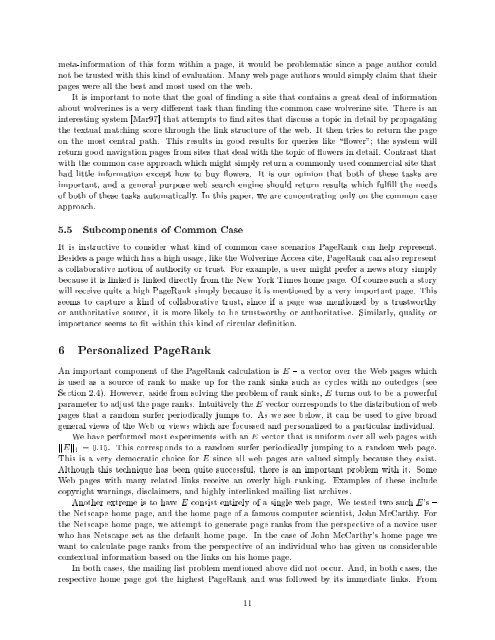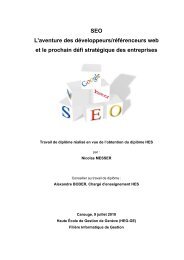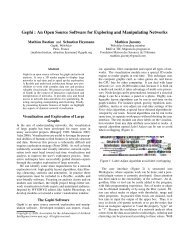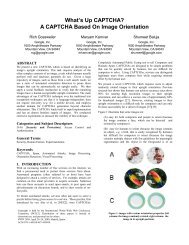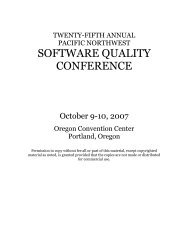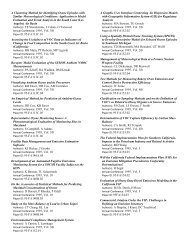The PageRank Citation Ranking: Bringing Order to the ... - Dejan SEO
The PageRank Citation Ranking: Bringing Order to the ... - Dejan SEO
The PageRank Citation Ranking: Bringing Order to the ... - Dejan SEO
Create successful ePaper yourself
Turn your PDF publications into a flip-book with our unique Google optimized e-Paper software.
meta-information of this form within a page, it would be problematic since a page author couldnot be trusted with this kind of evaluation. Many web page authors would simply claim that <strong>the</strong>irpages were all <strong>the</strong> best and most used on <strong>the</strong> web.It is important <strong>to</strong> note that <strong>the</strong> goal of nding a site that contains a great deal of informationabout wolverines is a very dierent task than nding <strong>the</strong> common case wolverine site. <strong>The</strong>re is aninteresting system [Mar97] that attempts <strong>to</strong> nd sites that discuss a <strong>to</strong>pic in detail by propagating<strong>the</strong> textual matching score through <strong>the</strong> link structure of <strong>the</strong> web. It <strong>the</strong>n tries <strong>to</strong> return <strong>the</strong> pageon <strong>the</strong> most central path. This results in good results for queries like \ower"; <strong>the</strong> system willreturn good navigation pages from sites that deal with <strong>the</strong> <strong>to</strong>pic of owers in detail. Contrast thatwith <strong>the</strong> common case approach which might simply return a commonly used commercial site thathad little information except how <strong>to</strong> buy owers. It is our opinion that both of <strong>the</strong>se tasks areimportant, and a general purpose web search engine should return results which fulll <strong>the</strong> needsof both of <strong>the</strong>se tasks au<strong>to</strong>matically. In this paper, we are concentrating only on <strong>the</strong> common caseapproach.5.5 Subcomponents of Common CaseIt is instructive <strong>to</strong> consider what kind of common case scenarios <strong>PageRank</strong> can help represent.Besides a page which has a high usage, like <strong>the</strong> Wolverine Access cite, <strong>PageRank</strong> can also representa collaborative notion of authority or trust. For example, a user might prefer a news s<strong>to</strong>ry simplybecause it is linked is linked directly from <strong>the</strong> New York Times home page. Of course such a s<strong>to</strong>rywill receive quite a high <strong>PageRank</strong> simply because it is mentioned by avery important page. Thisseems <strong>to</strong> capture a kind of collaborative trust, since if a page was mentioned by a trustworthyor authoritative source, it is more likely <strong>to</strong> be trustworthy or authoritative. Similarly, quality orimportance seems <strong>to</strong> t within this kind of circular denition.6 Personalized <strong>PageRank</strong>An important component of <strong>the</strong> <strong>PageRank</strong> calculation is E { a vec<strong>to</strong>r over <strong>the</strong> Web pages whichis used as a source of rank <strong>to</strong> make up for <strong>the</strong> rank sinks such as cycles with no outedges (seeSection 2.4). However, aside from solving <strong>the</strong> problem of rank sinks, E turns out <strong>to</strong> be a powerfulparameter <strong>to</strong> adjust <strong>the</strong> page ranks. Intuitively <strong>the</strong> E vec<strong>to</strong>r corresponds <strong>to</strong> <strong>the</strong> distribution of webpages that a random surfer periodically jumps <strong>to</strong>. As we see below, it can be used <strong>to</strong> give broadgeneral views of <strong>the</strong> Web or views which are focussed and personalized <strong>to</strong> a particular individual.We have performed most experiments with an E vec<strong>to</strong>r that is uniform over all web pages withjjEjj 1 = 0:15. This corresponds <strong>to</strong> a random surfer periodically jumping <strong>to</strong> a random web page.This is a very democratic choice for E since all web pages are valued simply because <strong>the</strong>y exist.Although this technique has been quite successful, <strong>the</strong>re is an important problem with it. SomeWeb pages with many related links receive an overly high ranking. Examples of <strong>the</strong>se includecopyright warnings, disclaimers, and highly interlinked mailing list archives.Ano<strong>the</strong>r extreme is <strong>to</strong> have E consist entirely of a single web page. We tested two such E's {<strong>the</strong> Netscape home page, and <strong>the</strong> home page of a famous computer scientist, John McCarthy. For<strong>the</strong> Netscape home page, we attempt <strong>to</strong> generate page ranks from <strong>the</strong> perspective ofanovice userwho has Netscape set as <strong>the</strong> default home page. In <strong>the</strong> case of John McCarthy's home page wewant <strong>to</strong> calculate page ranks from <strong>the</strong> perspective ofan individual who has given us considerablecontextual information based on <strong>the</strong> links on his home page.In both cases, <strong>the</strong> mailing list problem mentioned above did not occur. And, in both cases, <strong>the</strong>respective home page got <strong>the</strong> highest <strong>PageRank</strong> and was followed by its immediate links. From11


